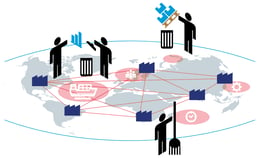Why Your Business Should Plan for Global Deployment
Kristin Masters - January 12, 2017

The role of international trade and investment has grown steadily since World War II. Yet we think of globalization as a relatively recent trend; indeed, rapid technological advances and other factors have changed the scale and direction of globalization. While large, multinational corporations once dominated the global market, now smaller enterprises have also gained entry.
For supply chain leaders, globalization offers new opportunities — and makes planning for global deployment a necessity rather than an option. Although planning for global deployment can present its challenges, it also positions your business to thrive as an active member of the new global economy.
Technology and the Global Supply Chain
Global supply chains have existed in some form as long as trade in intermediate products has existed. But rapid technological advances of the modern era have played a key role in the recent evolution of the global supply chain:
- The Internet of Things (IoT) connects devices all over the world, allowing them to share data in real time.
- Cloud computing has made applications much more scalable, increasing organizations' capacity for expansion and data storage.
- Machine learning permits the automation of processes that previously required human oversight, reducing the human capital necessary for international expansion.
Coupled with advanced analytics and robust logistics software, these technologies offer an excellent platform for global deployment. But the technology alone isn't enough to ensure a smooth deployment process. Supply chain leaders must work closely with their Sales and Operations Planning (S&OP) and Sales and Operations Execution (S&OE) teams to ensure that the organization reaps the multiple benefit of global deployment.
Benefits of Global Deployment
We live in an era of Industry 4.0: soon every supply chain will be a global supply chain. Companies that have already embraced globalization and executed successful global deployments have enjoyed multiple significant benefits, which include the following.
- Diversified business and trading: Global deployment enables an organization to tap into new markets and diversify its business opportunities.
- Access to new connections: Organizations are increasingly forging relationships with new business partners across borders, yielding new strategic alliances and ventures.
- Improved production cycle and delivery times: The ability to locate production facilities closer to raw materials and/or end customers shortens both production cycle and delivery time — not to mention transportation costs.
- Reduced costs for materials and labor: Moving beyond the local market often means that companies save money on raw materials and labor.
All these obviously contribute to higher profits. Realizing these benefits requires supply chain leaders to look beyond traditional deployment methods, which often result delays, budget overruns and even loss of control.
Avoiding the Pitfalls of Global Deployment
Traditional methods of global deployment can be costly and time consuming. They may even fail entirely. That's because these methods don't account for the demands of today's global supply chain. This supply chain doesn't just cross borders; it also crosses the organization — horizontally and vertically — and extends beyond, encompassing suppliers and end users alike.
The first step to implementing and maintaining such a robust supply chain is simple: planning. For example, it's important to consider the most effective ways to leverage technology along the supply chain, and to choose technology wisely. Without the right technology underpinning the supply chain, critical data won't be accessible or actionable. Instead of starting with fancy technology like robots, supply chain leaders should start with choosing the right logistics software and machine learning solutions for their enterprise environment.
Another potential pitfall of global deployments lies in management of new business relationships among suppliers, distributors and other members of the supply chain beyond your organization. These alliances are increasingly critical to facilitate entry into new market and diffuse risk. It's important to enter these partnerships with a shared expectation of true end-to-end (E2E) visibility.
Finally, global deployment requires a firm commitment to both S&OP and S&OE. Without both of these, daily complications in the supply chain will be magnified, wreaking havoc on near-term operations and long-term projections. To successfully scale for the global market, your organization must also scale these two functions. S&OP and S&OE both also bring additional visibility across the supply chain, resulting in more strategic alignment across your organization.
While global deployment may seem like a faraway goal for some organizations, it is increasingly becoming the industry norm. Executed effectively, global deployment confers plenty of benefits that make it worth the investment of time and resources.
If you want to learn more get your Guide to Industry 4.0:
LATEST POSTS
- Understand Why Production Planning Needs Specialized Solutions
- Understand Circular Economy in The Manufacturing Industry
- How Can Industry 4.0 IT Integration Be Achieved Smoothly?
- The Significance of Order Sequencing in Discrete Manufacturing
- How to improve your Supply Chain Management: The Power of Control Towers



